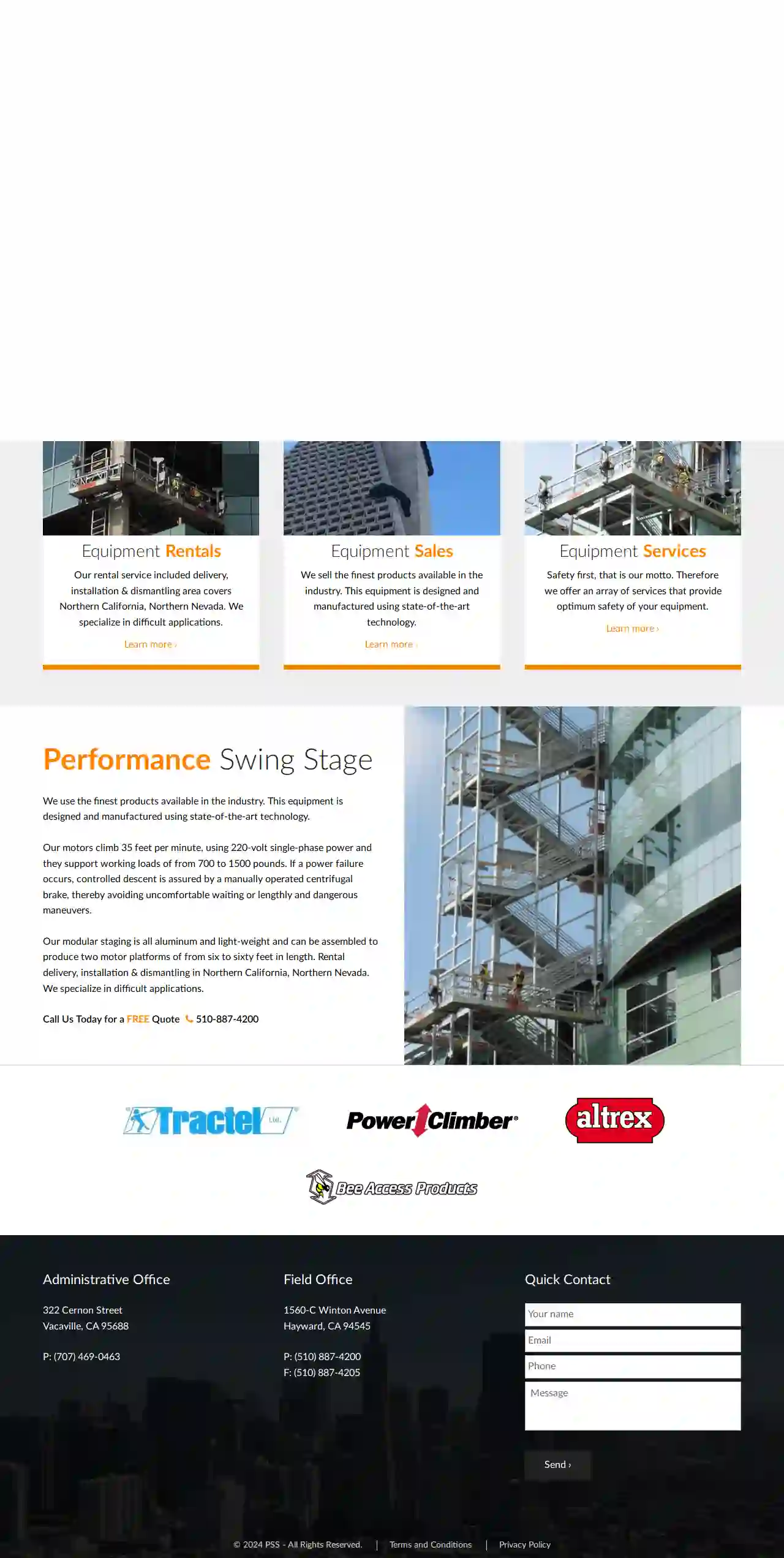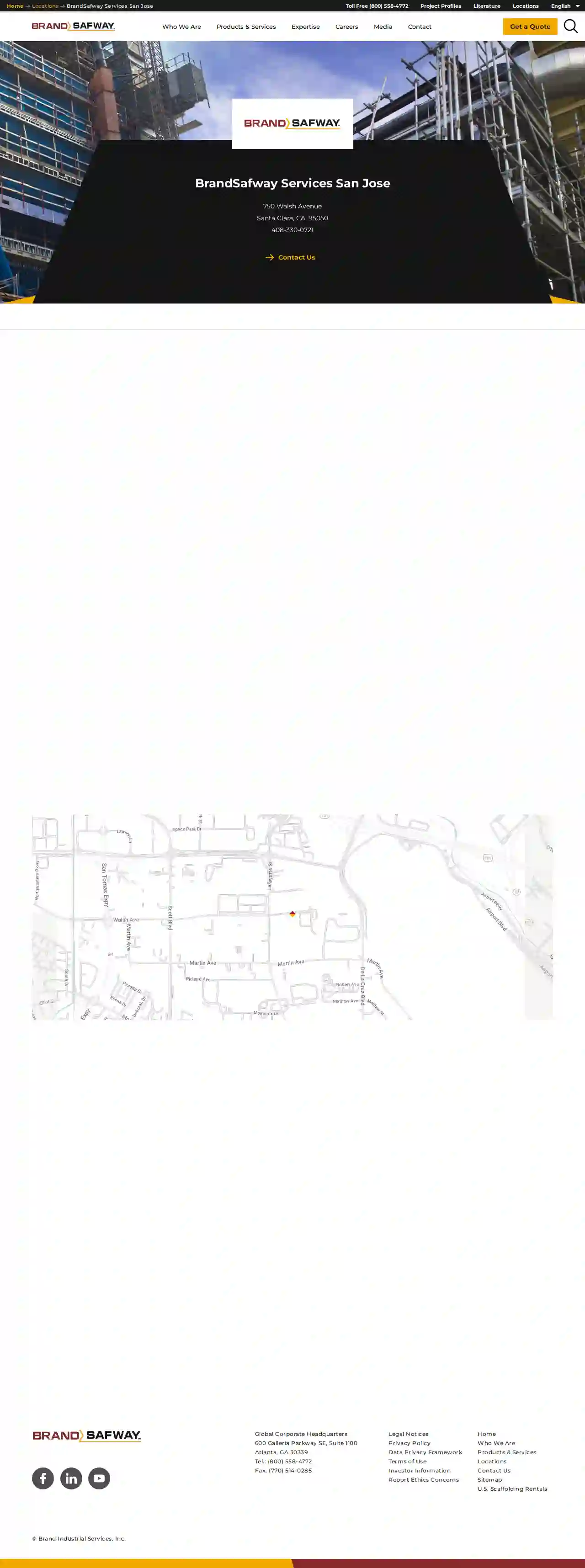Scaffolding Companies Rapid Valley
Top 10 Scaffolding Erectors in Rapid Valley
Get multiple Construction Scaffolding quotes for your project today! Compare profiles, reviews, accreditations, portfolio, etc... and choose the best deal.

Performance Swing Stage
Vacaville, CA, 322 Cernon Street, 95688, USPerformance Swing Stage specializes in providing top-notch scaffolding equipment services, including suspended stage rentals, building interior and exterior access, bridge work, refineries, dam work, confined spaces, and more. With a focus on safety, they offer equipment inspection and testing, exterior building maintenance systems, sales, and upgrades. Their coverage area spans Northern California, Northern Nevada, and the Western United States for permanently installed equipment. They prioritize safety and customer satisfaction, offering OSHA certifications, customer hoist inspections, and repairs.
- Services
- Why Us?
- Accreditations
- Our Team
- Testimonials
- Gallery
Get Quote
Savage Scaffold & Equipment
4.664 reviewsLayton, USAt Savage Scaffold & Equipment, we specialize in providing top-quality scaffolding and ladder equipment to help you get the job done right. We offer a wide range of products for rent and sale, ensuring you find the perfect match for your project. Our commitment to quality is unwavering, and we guarantee that our products will meet your expectations. Our extensive rental stock includes system scaffolds, rolling scaffold towers, suspended scaffolds, temporary stairways, and more. We also offer wholesale commercial pricing on select products, including Payson Casters and Werner Ladders. With our expertise and dedication to customer satisfaction, you can trust us to provide the best selection and availability in scaffolding products. Serving Utah, Idaho, Wyoming, and Northern Nevada, we're here to help you succeed.
- Services
- Why Us?
- Gallery
Get Quote
SkyBlue Builders Inc.
520 reviewsSuite 100, 123 Main St, Redwood City, 94043, USAt SBB, we pride ourselves on being one of the most respected renovation contractors in the Bay Area. With a commitment to quality and customer satisfaction, we offer a wide range of services including painting, complete remodeling, general construction, siding, windows, decks, and seismic retrofitting. Our team of experts is dedicated to delivering flawless finishes and creating the perfect living space for our clients. With flexible financing options and a focus on meeting our clients' expectations, we're the go-to choice for homeowners and businesses in the Bay Area. Whether it's a residential home or commercial building, we provide proven systems with industry-leading warranties and stay up-to-date with the latest technologies to ensure the longevity of your property. We're proud to be a Top-Rated contractor on HomeAdvisor and look forward to working with you.
- Services
- Why Us?
- Accreditations
- Our Team
- Testimonials
- Gallery
Get Quote
Nur HVAC
4.9115 reviews1078 Wentworth St, Mountain View, CA, 94043, USNur HVAC is a professional HVAC service provider offering a wide range of services including HVAC installation, HVAC repair, and more. With a team of skilled technicians, they ensure reliable and efficient solutions for their clients. Their mission is to provide fast, honest, and friendly service that exceeds customer expectations.
- Services
- Why Us?
- Accreditations
- Our Team
- Testimonials
- Gallery
Get Quote
Empire Sidewalk Shed & Scaffolding
54 reviewsNew York, NY, 156 5th Ave, 10010, USEmpire Sidewalk Shed & Scaffolding is a full-service company offering scaffold, hoisting, shoring systems, and other relevant equipment. We are committed to bringing excellence and comply with the highest standards of safety. Our experienced and reliable professionals make sure that we offer the best of both worlds to our valuable clients. From being the helping hand in new construction projects to carrying out high-end demolition jobs, we will be at your disposal. We are among one of the largest suppliers of scaffolding, temporary fences, construction fences, and other equipment in the USA. Our company is providing reliable solutions to the customers. Providing extremely versatile and robust working platforms to create safe and convenient working areas is our norm. Our core business is mainly focused on product rental, offering integral solutions and services in formwork and scaffolding technology.
- Services
- Why Us?
- Gallery
Get Quote
Hitech sidewalk shed & scaffolding
52 reviews1724 Amsterdam Ave, New York, 10031, USHiTech Sidewalk Shed & Scaffolding is a one-stop supplier of construction and general equipment. From painting to roofing, window installation, and brickwork, we have scaffolding to suit your needs. We believe that all problems can be solved as soon as they occur. We started this company because we felt there was a market for rental scaffolding. Our mission is to become your dependable and reliable source for any scaffolding needs in all five boroughs of New York City, Brooklyn, Queens, Bronx, Westchester and Manhattan. We are committed to providing you with our prime, hassle-free services on various projects through our reliable veterans. Get ahold of us 24 hours per day from Monday to Sunday. Our services include sidewalk shed rentals, scaffolding rental, pipe scaffolding rental, and hanging scaffold rental.
- Services
- Why Us?
- Accreditations
- Testimonials
- Gallery
Get Quote
Gordon's Ace Hardware
4.8142 reviews3067 N Canyon Rd, Provo, 84604, USAt Ace Hardware, we're more than just a hardware store. We're your local experts, committed to helping neighbors like you with quality products, personal service, and a convenient shopping experience. As one of 5,000+ Ace stores locally owned and operated across the globe, we're proud to be a part of your community. Our team is dedicated to being 'the Helpful Place' by offering expert advice, a wide selection of products, and a commitment to customer satisfaction. Whether you're a homeowner, DIY enthusiast, or professional contractor, we're here to help you get the job done right.
- Services
- Why Us?
- Accreditations
- Our Team
- Gallery
Get Quote
BrandSafway Solutions Salt Lake City – Scaffolding, Access & Industrial Solutions
4.511 reviews1234 Industrial Drive, Salt Lake City, 84101, USBrandSafway is a leading provider of access solutions, including scaffolding, aerial work platforms, and forming and shoring equipment. With a strong commitment to safety, quality, and customer satisfaction, BrandSafway offers comprehensive solutions tailored to meet the unique needs of clients across various industries. Their team of experienced professionals works closely with clients to understand their requirements and deliver customized solutions that enhance efficiency, productivity, and safety on site. BrandSafway's Salt Lake City branch serves as a hub for regional operations, providing top-notch services and equipment to clients in the area.
- Services
- Why Us?
- Accreditations
- Our Team
- Testimonials
Get Quote
BrandSafway Services San Jose
44 reviews1234 BrandSafway Blvd, San Jose, 95002, USBrandSafway is a leading provider of access solutions, including scaffolding, aerial work platforms, and forming and shoring equipment. With a strong commitment to safety, quality, and customer satisfaction, BrandSafway offers a wide range of services tailored to meet the unique needs of clients across various industries. Their team of experienced professionals works closely with clients to understand their requirements and deliver customized solutions that enhance efficiency and productivity. BrandSafway is dedicated to providing innovative solutions that meet the highest standards of safety and quality, ensuring successful project outcomes and long-term partnerships.
- Services
- Why Us?
- Accreditations
- Our Team
- Testimonials
Get Quote
Duty scaffold inc
San Fernando, USSolidify your work with SoCal’s #1 Scaffolding Company. At Duty Scaffold Inc, our mission is to provide safe, reliable, and guaranteed solutions that empower construction and maintenance projects. We are dedicated to ensuring the well-being of our employees, partners, and the communities we serve. Through continuous improvement, sustainable practices, and exceptional customer service, we aim to be the scaffolding industry’s trusted partner, contributing to the success and safety of every project we support. Our values are the foundation of our business, guiding our actions and decisions in everything we do. We believe in hard work, honesty, reliability, trust, community, employees, responsibility, and perfectionism. These values define who we are as a company and how we aim to contribute to the success and well-being of all our stakeholders.
- Services
- Why Us?
- Our Team
- Gallery
Get Quote
Over 2,353+ Scaffolding Companies on our directory
Our scaffolding contractors operate in Rapid Valley & beyond!
ScaffoldingHQ has curated and vetted the Best Scaffolding Companies arround Rapid Valley. Find a top & trustworthy contractor today.
Frequently Asked Questions About Scaffolding Companies
- Project Height and Access: The height of the structure and the accessibility of the working area are primary considerations.
- Load Capacity: The weight of workers, materials, and equipment that the scaffolding needs to support.
- Project Complexity and Shape: The shape and complexity of the structure may necessitate specialized scaffolding configurations.
- Ground Conditions: The type of ground (soft, uneven, sloping) will influence the scaffolding foundation and support requirements.
- Duration of Use: The length of time the scaffolding will be needed can impact the choice of system.
- Budget: Different scaffolding types have varying costs.
- Steel: The most common material due to its strength, durability, and resistance to corrosion.
- Aluminum: Lighter than steel, often used for smaller projects or where weight is a concern.
- Timber: Used for decking platforms and some traditional scaffolding structures. It's less common now due to its susceptibility to rot and damage.
- Fiberglass: Used in specialized applications where electrical conductivity is a concern.
- Mobile Elevated Work Platforms (MEWPs): Scissor lifts, boom lifts, and other MEWPs offer flexible access for specific tasks.
- Mast Climbing Work Platforms (MCWPs): Ideal for high-rise construction, providing a stable working platform that can be raised incrementally.
- Suspended Access Equipment: Ropes and harnesses used for specific tasks like window cleaning or façade repairs.
- Ladders and Step Ladders: For shorter durations and limited working heights, provided they are used safely and appropriately.
- Workers: Consider the number of workers on the scaffolding at any given time.
- Materials: Include the weight of building materials, tools, and equipment being used on the platform.
- Environmental Factors: Factor in potential loads from wind or snow, especially for taller scaffolding structures.
How do I choose the right type of scaffolding for my project?
What are some common materials used in scaffolding?
What are some alternatives to traditional scaffolding?
What is the weight limit for scaffolding?
How do I choose the right type of scaffolding for my project?
- Project Height and Access: The height of the structure and the accessibility of the working area are primary considerations.
- Load Capacity: The weight of workers, materials, and equipment that the scaffolding needs to support.
- Project Complexity and Shape: The shape and complexity of the structure may necessitate specialized scaffolding configurations.
- Ground Conditions: The type of ground (soft, uneven, sloping) will influence the scaffolding foundation and support requirements.
- Duration of Use: The length of time the scaffolding will be needed can impact the choice of system.
- Budget: Different scaffolding types have varying costs.
What are some common materials used in scaffolding?
- Steel: The most common material due to its strength, durability, and resistance to corrosion.
- Aluminum: Lighter than steel, often used for smaller projects or where weight is a concern.
- Timber: Used for decking platforms and some traditional scaffolding structures. It's less common now due to its susceptibility to rot and damage.
- Fiberglass: Used in specialized applications where electrical conductivity is a concern.
What are some alternatives to traditional scaffolding?
- Mobile Elevated Work Platforms (MEWPs): Scissor lifts, boom lifts, and other MEWPs offer flexible access for specific tasks.
- Mast Climbing Work Platforms (MCWPs): Ideal for high-rise construction, providing a stable working platform that can be raised incrementally.
- Suspended Access Equipment: Ropes and harnesses used for specific tasks like window cleaning or façade repairs.
- Ladders and Step Ladders: For shorter durations and limited working heights, provided they are used safely and appropriately.
What is the weight limit for scaffolding?
- Workers: Consider the number of workers on the scaffolding at any given time.
- Materials: Include the weight of building materials, tools, and equipment being used on the platform.
- Environmental Factors: Factor in potential loads from wind or snow, especially for taller scaffolding structures.